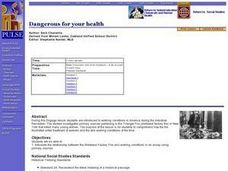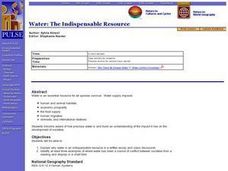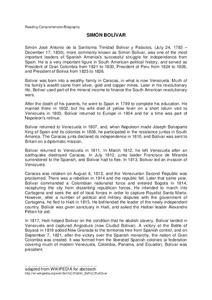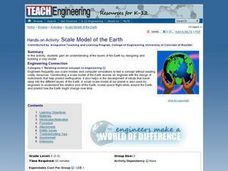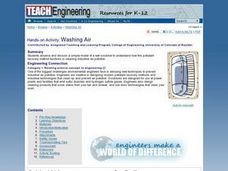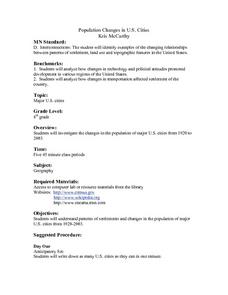Curated OER
GPS Receiver Basics
Students practice using a GPS receiver. They walk in different directions and monitor their progress on maps. They enter specific locations and use information given to them to get them back to their original locations.
Curated OER
I Breathe What?
Pupils participate in an experiment in which they gather and examine particiles in the air. They place pollution detectors at different locations and identify problem areas. They discuss how engineers can use this type of information...
Curated OER
Feng Shui for the Budding Interior Decorator
Young scholars examine the uses and beliefs associated with the Chinese art of Feng Shui. The class reads about the traditional uses of Feng Shui. Individually, each student creates a room makeover using Feng Shui principles.
Curated OER
Year of the Impossible Goodbyes by Sook Nyul Choi
Students analyze Korean culture from their literature piece. They investigate the theme of oppression by an occupying army. Students encounter courage, resistance movements and explore the underground railroads.
Curated OER
Changing Opinions
Pupils compare their preconceptions of Native American movement with their current perceptions. They identify why they have changed. Students conclude with a final reflection addressing how they define the Native American experience in...
Curated OER
Dangerous for your health
Students articulate the relationship between the Shirtwaist Factory Fire and working conditions in an essay using primary sources. They are introduced to working conditions in America during the Industrial Revolution.
Curated OER
Pollutants and Contaminants
Students define pollution and contaminants by constructing a Definition and Concept Trail that illustrates how they are connected to health. They give examples of health issues during the Industrial Revolution by conducting textbook...
Curated OER
American Migrations Timeline
In order to answer the question of whether the United States is a country of migrants or immigrants, learners compile a list of migrations in America. From this list they conduct individual research for a particular episode of migration...
Curated OER
World Geography: Water: The Indispensable Resource
Learners are able to explain why water is an indispensable resource in a written essay and class discussion. They identify at least three examples of where water has been a source of conflict between societies from a reading and...
Curated OER
Diversity Under the Roof of the World
Students learn about Nepals many cultures, religions, and landscape. They compare a Nepal student to an American student and relate location, place, and culture of American and Nepals. They discuss reasons why they think there is such...
Curated OER
Reading Comprehension: Simon Bolivar
In this reading comprehension/biography worksheet, students read 2 pages of information about Simon Bolivar. No comprehension questions are included, worksheets are for informational reading only.
Curated OER
Breaking News English: Hawaii Hit by Great Plastic Garbage Patch
In this English worksheet, students read "Hawaii Hit by Great Plastic Garbage Patch," and then respond to 1 essay, 47 fill in the blank, 7 short answer, 2 graphic organizer, 20 matching, and 8 true or false questions...
Curated OER
Destination-Northern Ireland
Students explore Northern Ireland. For this social studies lesson, students read about Northern Ireland and write questions about the reading. Students share their questions with classmates.
Curated OER
Breaking Beams
Students work together designing and building their own beams. They discover the concepts of stress and strain. They participate in a competition to determine the best beam.
Curated OER
Scale Model of the Earth
Learners work together to create a model of the Earth. They label and identify each layer and describing its properties. They discover how engineers use models to test different concepts.
Curated OER
Washing Air
Young scholars observe a model of a wet scrubber. They discuss this and other methods of pollutant recovery. They discover how engineers use this information to protect the environment.
Curated OER
NCTA Lesson Plan on Korea
Young scholars are introduced to the unique aspects of the Korean culture. Using the websites included in the lesson they research categories of subjects that are related to the culture.
Curated OER
Forces on the Human Molecule
Students conduct several simple lab activities to explore the five fundamental load types that can act on structures: tension, compression, shear, bending, and torsion. In this activity, students play the role of molecules in a beam...
Curated OER
Invent a Backscratcher from Everyday Materials
Students explore the design process. They discuss why new products are made, examine backscratchers brought in from home and discuss why it is a useful device, and working with a partner draw and construct a backscratcher.
Curated OER
Heavy: The Story of Metal (Part 2)
Students discuss censorship of music and other art forms. Students create their own list of criteria for acceptable music. Students write a list of their own "Filthy fifteen" based on their criteria for acceptable music.
Curated OER
Special Delivery-Opinion
Students are introduced to the concept of global climate change. Using data, they determine how much of the world is being affected by the increase in temperatures. They complete a worksheet and consider the evidence giving to them and...
Curated OER
Research Based Writing
Eighth graders practice researching and exploring given websites and writing a paragraph on the content of each. As a class, they determine the value of each site, discuss plagiarism, and the need for paraphrasing information. Students...
Curated OER
Research-based Writing
Eighth graders explore the steps for research based writing. In the computer lab, they examine approved, given websites. After observing a chosen site, 8th graders write a paragraph describing the websites' content. They discuss...
Curated OER
Population Changes in U.S. Cities
Students investigate the changes in the population of major U.S. cities from 1920 to 2003. They write down as many U.S. cities as they can in one minute. Students discuss the top five cities on their lists and they disucss why there are...







